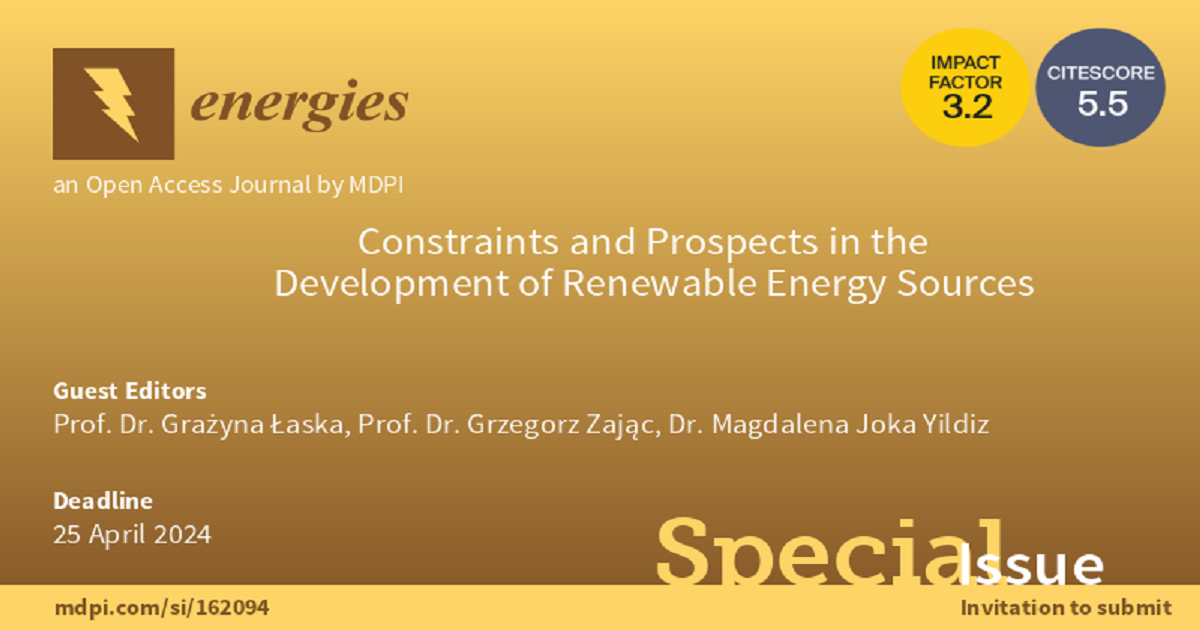Constraints and Prospects in the Development of Renewable Energy Sources
A special issue of Energies (ISSN 1996-1073). This special issue belongs to the section "A: Sustainable Energy".
Deadline for manuscript submissions: closed (12 December 2024) | Viewed by 14134

Special Issue Editors
Interests: renewable energy sources; biomass; wind energy; photovoltaics; GIS; biodiversity; ecosystem ecology; ecosystem serivce; MCDA
Interests: renewable energy; combustion biomass; waste conversion; biomass processing; biofuel; alternative fuels for engines; emission reduction technologies
Special Issue Information
Dear Colleagues,
As part of a Special Issue in the journal Energies, we wish to present the results of innovative research works and technologies concerning renewable energy sources, taking into account all paths of limitations and prospects for their development. The presented articles’ aim is to enable a thorough analysis of future joint actions for the climate and environment. Areas of interest include, but are not limited to, the following topics:
- Characteristics of energy generation systems; energy generation systems and the natural environment.
- Biomass and biofuels; systems for generating electricity and heat using biomass.
- Wind energy; current status and development opportunities for wind energy; ecological and economic aspects of using renewable energy sources.
- Hydropower; the energy of tides, waves and sea currents; the thermal energy of seas and oceans; ecological and economic aspects of using renewable energy sources.
- Solar energy; passive and active solar energy utilization systems; solar panels; photovoltaic cells; solar power plants.
- Geothermal energy; the use of geothermal energy in the process of electricity and heat production.
- Environmental problems related to RES and their impacts on biotic and abiotic components of the environment and the landscape.
- Good practices in the development of RES.
Prof. Dr. Grażyna Łaska
Prof. Dr. Grzegorz Zając
Dr. Magdalena Joka Yildiz
Guest Editors
Manuscript Submission Information
Manuscripts should be submitted online at www.mdpi.com by registering and logging in to this website. Once you are registered, click here to go to the submission form. Manuscripts can be submitted until the deadline. All submissions that pass pre-check are peer-reviewed. Accepted papers will be published continuously in the journal (as soon as accepted) and will be listed together on the special issue website. Research articles, review articles as well as short communications are invited. For planned papers, a title and short abstract (about 100 words) can be sent to the Editorial Office for announcement on this website.
Submitted manuscripts should not have been published previously, nor be under consideration for publication elsewhere (except conference proceedings papers). All manuscripts are thoroughly refereed through a single-blind peer-review process. A guide for authors and other relevant information for submission of manuscripts is available on the Instructions for Authors page. Energies is an international peer-reviewed open access semimonthly journal published by MDPI.
Please visit the Instructions for Authors page before submitting a manuscript. The Article Processing Charge (APC) for publication in this open access journal is 2600 CHF (Swiss Francs). Submitted papers should be well formatted and use good English. Authors may use MDPI's English editing service prior to publication or during author revisions.
Keywords
- biomass
- biofuels
- wind energy
- hydropower
- solar energy
Benefits of Publishing in a Special Issue
- Ease of navigation: Grouping papers by topic helps scholars navigate broad scope journals more efficiently.
- Greater discoverability: Special Issues support the reach and impact of scientific research. Articles in Special Issues are more discoverable and cited more frequently.
- Expansion of research network: Special Issues facilitate connections among authors, fostering scientific collaborations.
- External promotion: Articles in Special Issues are often promoted through the journal's social media, increasing their visibility.
- Reprint: MDPI Books provides the opportunity to republish successful Special Issues in book format, both online and in print.
Further information on MDPI's Special Issue policies can be found here.





